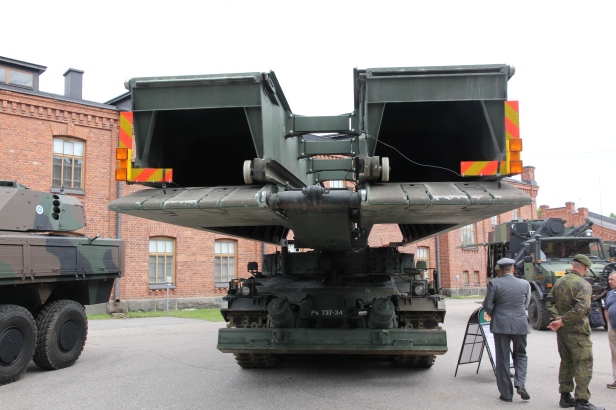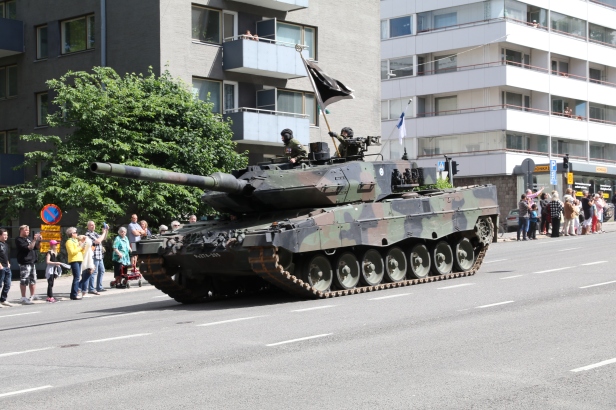The Finnish Army has always been largely infantry-based. This has come naturally, as not only is armour expensive, but it has also been seen as poorly suited for the Finnish terrain (a challenged notion) which in large parts of the country is dominated by forests and lakes, with differently sized streams connecting the latter. As such, there has been a single unit operating our tanks, known either as the Armoured Company/Battalion/Brigade/Division depending on the number of tanks in service at any given time. For the past decades, the Armoured Brigade (PSPR) has been based in Parolannummi, Hattula.

Here, an interesting variety of tanks have come and gone, with the last years being dominated by a fleet of Leopard 2A4 backed up by the venerable T-55 in small (and diminishing) numbers. 139 Leopard 2A4’s have been bought by Finland, some of which have been converted to bridge-layers (2L for ‘Leguan’) and engineering vehicles (2R for ‘Raivaaja’, Finnish for mine-clearing), as well as some hulls being cannibalised for spares. The eventual number of operational main battle tanks is secret, but assumed to be somewhere around 100.

The acquisition of 100 ex-Dutch Leopard 2A6’s effectively doubled the amount of MBT’s in Finnish service, as well as providing a considerable upgrade over the 2A4. The 2A6 is easily recognisable by the wedge-shaped spaced armour attached to the turret (introduced on the 2A5), as well as the longer Rheinmetall 120 mm L/55 smoothbore gun. A number of other less evident improvements are also found on the tank, ranging from upgraded sights for the gunner and commander to a new hatch for the driver.

This obviously raised the question what to do with the large number of 2A4’s? To begin with, it allowed the upgrading of some of the older supporting AFV’s, with the Marksman SPAAG being the most evident example. The 35 mm anti-aircraft system mounted on T-55AM hulls had already been mothballed, but was now brought back in service mounted on Leopard hulls. In addition, it opened up the possibility to increase the fighting value and/or number of Detached Armour Companies that are to be set up in case of mobilisation.
The latest decision was announced yesterday, with a number of Leopard 2A4’s moving out of Parolannummi.
Edit: As Capt. Mäenpää explained in his comment below, my interpretation of the press release was less than optimal.
Conscripts from four different brigades and the Army Academy will indeed get trained as tank crews on the Leopard 2A4 starting with I/17, with the stated aim being to provide a higher level of proficiency in working with armoured and mechanised units, as well as providing the opportunity for more varied training in different parts of the country. However, these units haven’t been complete strangers to MBT’s earlier, as limited numbers of T-54/55’s have served in the OPFOR role at the Jaeger and Kainuu Brigades as well as in the Army Academy. The Karelia Brigade has included some Leopard’s in their wartime units’ TOE earlier as well, so these tanks have trained at the brigade earlier. The main news here is therefore that the OPFOR equipment is being upgraded (and possibly expanded in numbers?), which certainly is welcome, but not the kind of dramatic change that my first reading of the press release pointed to. Also, the CV9030 in Finnish service is unique to the Karelia Brigade.
In what I believe is a first in the history of the Finnish armoured forces, conscripts will from four different brigades and the Land Battle School will serve as tank crews, starting with the next contingent to step into service, I/17. This will provide a higher level of proficiency in working with armoured and mechanised units to the soldiers serving in the units now getting tanks, as well as providing the opportunity for more varied training in different parts of the country.With regards to the former, the Karelia and Kainuu Brigades train mechanised infantry with CV 9030 IFV’s, and the addition of integrated tank units are probably a welcome addition for them. Granted, there has been a small number of T-55’s attached to the units earlier (and some engineering vehicles), but no tank crews have been trained on them, and the T-55 is a far cry from the Leopard when it comes to sensors (and more or less any other aspect). The Jaeger Brigade and Land Battle School Army Academy probably places a higher importance on the possibility to vary their training, with e.g. the Jaeger Brigade’s anti-tank unit now being able to train against modern tanks on a regular basis in their home environment.
While not explicitly stated as a goal, the move will also make it possible to mobilise (small) tank units in different parts of the country, which increases resilience to surprise attacks, the importance of which has been emphasised by the Russian invasion of Crimea. All in all, the move will provide a number of benefits to the armed forces, both with regards to peacetime training and wartime service.



Hey,
tank crews were trained on T-55M’s in the Karelian Brigade atleast during the late 90’s, although in small numbers. I don’t know if this was still done, but it could be in the case of Karelian Brigade that this was just an upgrade of equipment and not a completely new thing.
From the original article it sounds pretty much the same as it was earlier (training with infantry units to give them an idea how to work with and against tanks and also operating as OPFOR in exercises).
Bringing back and upgrading mothballed equipment? As a Swede that sounds outlandish – in Sweden “mothballing” means “take working equipment and destroy it in a few years instead of right away”. #jaded
On a serious note it sounds like a good idea to distribute some tanks to independent companies around the country. You never know when a few steel behemoths can come in handy.
Nice info, and very good that the “old” A4s will be distributed (which also indicate that their roles in the Mech Battle Groups will be taken by the A6.
Just a slight nitpick. The english name for Landsstridsskolan (Maatsotakoulu) is the Army Academy.
Thanks for pointing out, edited!
Land Battle School is Not correct for Maasotakoulu. Correct one is Army Academy.
Also Kainuu Brigade does not have CV9030’s. Only Karelian Brigade does. Also Karelian Brigade has trained Leopard 2A4’s before as its TOE has Tank companies along its Mechanized infantry companies.
So nothing New really: old T-54/55 and XA-180 based OPFOR units in in Jaeger BDE, Kainuu BDE and Army Academy will be reequip with Leopard 2A4. Karelia BDE will continiue Leopard 2A4 training to provide training partner to its Mech Infantry. Leopard 2A6’s to first line mechanized units will be trained in Armored BDE to its war time units and to Karelia BDE war time units.
Thanks for the reply, post updated accordingly!
There is no chance of the 2A4:s being upgraded, as there are a number of available upgrades?
That was the original plan, but then the possibility to buy the Dutch 2A6’s at a bargain price appeared. At some point some kind of MLU will be needed if the 2A4’s are kept in service, but there’s nothing in the cards at the moment as far as I’m aware of.
btw regarding the dutch deal, it was originally 100 but later the dutch decided to keep 20 , didn’t they?